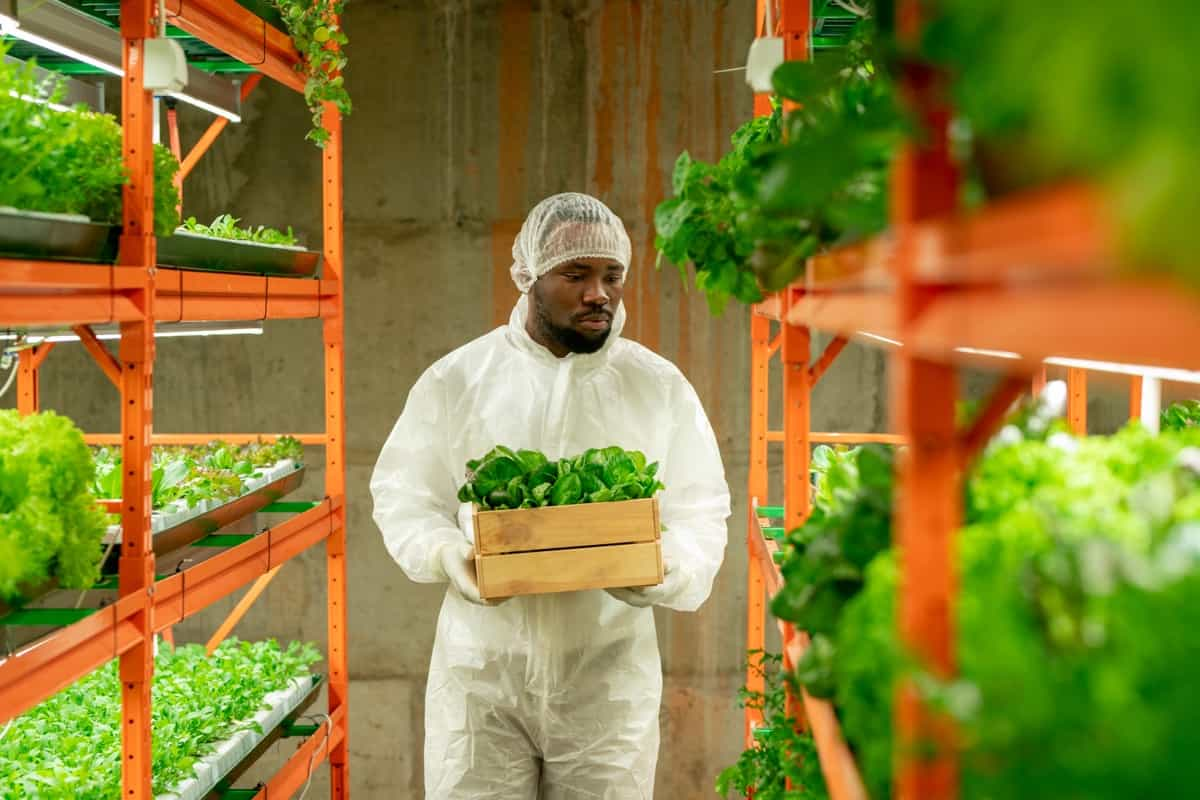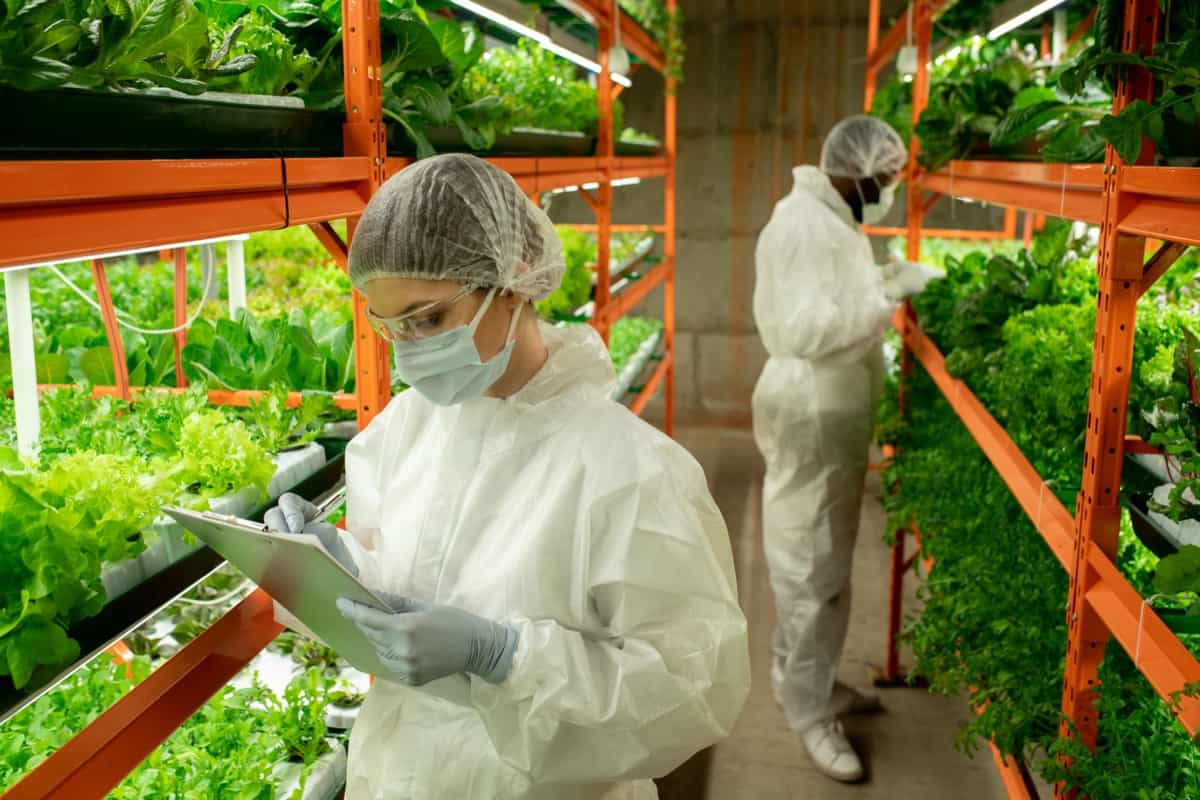The concept of vertical farming is exactly as it sounds: farming on vertical surfaces rather than on horizontal ones. Vertically stacked layers allow farmers to produce more food on the same land (or even less). Many of these layers are integrated into skyscrapers, warehouses, shipping containers, greenhouses, or other areas that would not normally be suitable for farming.

While vertical farming involves stacking plants and hoping for the best, it’s much more than that. To perform the practice, artificial temperatures, lights, water, and humidity must be controlled. It is possible to lose an entire crop if a delicate balance isn’t maintained, just as a traditional farm might in a drought or flood.
Vertical Farming Technology
A vertical farmer can monitor every environmental condition imaginable thanks to agricultural technology. The first step is monitoring, but it’s only the beginning. Connecting equipment to an operating system that automates processes and provides insights into data is the key to getting the most out of vertical farming technology. With actionable insights, yields can be predicted more accurately. The technology available to vertical farmers can be divided into several categories.
Monitor: A controlled environment growth operation is monitored using sensors placed throughout to collect data about the most significant aspects. Monitoring temperature, soil moisture, humidity, electrical conductivity, light, and carbon dioxide is essential. You can unlock the potential of your equipment by connecting these sensors.
Control: With industrial IoT controllers, you can support hundreds of intelligent devices throughout your indoor farm to deliver the ultimate intelligent farm experience. With smart motor controllers, you can program timers, schedules, open vents, etc., from your smartphone. Using crop steering guidelines, you can even direct the growth of plants.
Analyze: With a top-of-the-line operating system and connected devices, and you can gain clarity over farm data. Hundreds of data visualizations are available to help you gain meaningful insights. You can share data with your team using Excel integration.
Predict: Additionally, innovative businesses offer platforms with machine learning and artificial intelligence capabilities to predict the harvest size accurately.
In case you missed it: How to Start Vertical Hydroponic Farming at Home: Step-By-Step Guide for Beginners

How to Start a Vertical Farm
Choose a Site for a Vertical Farm
There are three basic requirements for the site of an urban farm facility: electricity, a running water supply, and a sewage system. Racks, pallets, pipes, tanks, lamps, and other equipment are stored on the concrete slab that supports the structure’s weight. An effective waterproof layer must be provided inside the walls, or the walls must have such a layer. T
he sandwich panels normally used for cooling chambers should provide thermal insulation for the growing chamber. A multi-story building’s basement; a former supermarket; underground parking; an old factory, warehouse, hangar, or a shopping center are all good locations for an automated vertical farm. 5 to 6.5 meters is the recommended height for the growing area.
Create a Vertical Farm Project Model
The first step is to gather detailed information about every fixed input cost: rent, water, and electricity. After that, a model of the facility needs to be created. In addition to racks and ventilation, drainage and sewerage, a fire exit, and a power supply, a detailed model should be made. Architects and builders are planning architecture and construction solutions at this point. It involves creating a list of construction and engineering equipment, an estimate, a financial model, and a project timeline.
Complete Construction of the Vertical Farm
Hiring contractors or connecting with builders in your area through your technology provider is possible. Depending on the expertise and workforce involved in the construction process, a 100 m2 farm can be set up and launched within 3 to 5 weeks, while a 1000+ m2 farm may require 3 to 4 months.
Integrate Vertical Farm Management Software
Integrating a software platform that will help you monitor and control your growing process is the final step before launching your farm. Several software features make running a vertical farm easy for anyone:
- Optimize production efficiency by automatically planning and scheduling plantings
- Detailed instructions (checklists) for plant care; daily staff tasks
- Manage the farm microclimate and production 24/7 from your device
- You can get a predicted yield at a desired time by using these calculations
- Reduction of farm staff workload by a significant amount
Plant the First Seeds and Teach Your Staff Vertical Farming Techniques
You can plant your first seeds now that your farm has been designed, built, verified, and cost-calculated. Your vertical farm will probably need staff training once the seeds are planted. You can also rely on a full-service farm tech provider to help you buy the seeds, plant the first crop, and train your employees.
Set Up Deliveries of Consumable Items for Your Indoor Farm
Vertical farms require substrate, seeds, pots, packaging, fertilizers, etc., among other items. Fertilizer costs vary depending on the producer and the type of fertilizer you choose. Technology providers can supply these items directly through software platforms integrating the purchasing process.
What Is the Timeframe for Starting a Vertical Farm?
Here is a sample timeline to launch a farm with a total floor area of 500 m²
| Activity | Time |
| Prepare a concept project | 4 weeks |
| Deliver equipment | 4 weeks |
| Install the farm | 3-5 weeks |
| Plant the first seeds and train plant growers | 2 weeks |
Benefits of Vertical Farming
Vertical farming has many benefits, such as maximum output, minimal environmental impact, and much less space needed. Using traditional food production methods will become increasingly difficult as resources become scarce.
Utilize Less Water & Space
With vertical farming techniques, farmers can use 98 percent fewer water resources and 99 percent fewer acres of land. Through perpetual or rolling harvests, they can produce crop yields 240 times greater than traditional farms. Since our crops are powered by the sun rather than LED lights, they are not dependent on fossil fuels.
Increased Production All Year
The benefits of vertical farming include increased production overall and consistent production throughout the year. It is no longer the case that some fruits and vegetables are only available during certain seasons. Instead, vertical farms can produce a wide range of crops year-round regardless of the weather.
In case you missed it: How to Start a Fruit Juice Production in India: A Profitable Business Idea for Fruit Farmers

Controlled Environment Agriculture (CEA) Eliminates Environmental Impacts
Controlled environment agriculture (CEA) is often included in indoor vertical farming. Various technologies are designed to provide optimal plant conditions as part of CEA. Farmers can grow plants that wouldn’t otherwise be able to grow in their climate and weather by regulating temperature, lighting, and humidity.
Conclusion
Vertical farming is an alternative to large farms transporting fruit and vegetables long distances in trucks and planes. Consequently, less fuel is used, and the food is fresher. As long as the growing environment is controlled carefully, products can last for 13 to 14 days, compared to three to four days for conventionally grown products.
- Feed Your Flock for Less: Top 10 Tips to Save on Chicken Feed
- Ultimate Guide to Ossabaw Island Hog: Breeding, Raising, Diet, and Care
- Hatching Answers: The Top 10 Reasons Your Chickens Aren’t Laying Eggs
- Eggs and Economics: Breaking Down the Cost of Raising Backyard Chickens
- Defend Your Greens: Proven Methods to Keep Iguanas Out of Your Garden
- Ultimate Guide to Cinnamon Queen Chicken: A Comprehensive Guide for Beginners
- Ultimate Guide to California Tan Chicken: Breeding, Raising, Diet, Egg-Production and Care
- Ultimate Guide to Marsh Daisy Chicken: Breeding, Raising, Diet, and Care
- 10 Types of Chicken Farming Businesses You Can Start for Profits